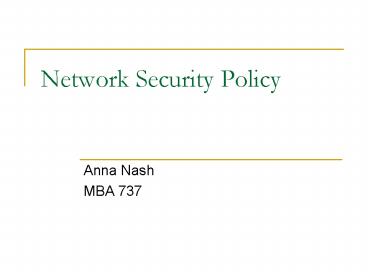Network Security Policy - PowerPoint PPT Presentation
1 / 18
Title:
Network Security Policy
Description:
Network Security Policy Anna Nash MBA 737 Agenda Overview Goals Components Success Factors Common Barriers Importance Questions Overview A Network Security Policy ... – PowerPoint PPT presentation
Number of Views:386
Avg rating:3.0/5.0
Title: Network Security Policy
1
Network Security Policy
- Anna Nash
- MBA 737
2
Agenda
- Overview
- Goals
- Components
- Success Factors
- Common Barriers
- Importance
- Questions
3
Overview
- A Network Security Policy
- Provides rules for access to and proper use of
computer and network resources - Defines procedures to prevent and respond to
improper use of network components, including
associated data and systems
4
Goals
- The goal of Network Security Policy is to
- Strategically align network controls with
enterprise business objectives in a value added
fashion - Provide the appropriate mechanisms for
effectively managing risk related to the network
infrastructure and network-accessible assets - Provide the metrics needed to ensure that network
security risks are appropriately mitigated and
access policies effectively followed
5
Components
- Network security policies are subjective,
developed to meet the specific goals and risks of
each individual organization - However, there are components common to all
successful network security policies, including - Asset Management
- HR Security
- Physical Security
- Communications/Operations Management
- Access Control
- Software Security
- Incident Management
- Business Continuity Management
- Compliance
6
Components Asset Management
- Asset Management is the set of policies and
procedures designed to protect organizational
assets - Assets include information, software assets,
physical assets, people and intangibles such as
reputation - Typical Asset Management Policies include
- Inventory
- Ownership Assignment
- Defined Acceptable Use
7
Components HR Security
- HR Security is the set of policies and procedures
designed to ensure employees, contractors and
third party users understand their
responsibilities and are an appropriate fit for
their role(s) within the organization. - HR policies can be targeted to different
timeframes - Prior to employment
- During employment
- Termination / Change of employment
- Typical HR Security Policies include
- Screening / Background Checks
- Security Awareness Training
- Disciplinary Processes
- Termination Responsibilities
- Removal of Access Rights
8
Components Physical Security
- Physical Security is the set of policies and
procedures designed to prevent unauthorized
physical access, damage and interference to the
organizations physical premises and information - Should also prevent loss or theft of physical
assets - Typical Physical Security Policies include
- Physical entry policies
- Security of offices, rooms and facilities
- Equipment maintenance procedures
- Security of equipment off-premises
- Disposal or removal of property
9
Components Communications/Operations Mgt.
- Communications and Operations Management policies
and procedures are designed to ensure the correct
and secure operation of IT facilities - This encompasses a broad set of controls
including - Malicious code protection
- Back-Ups
- Network Controls
- Handling and Disposal of removable media
- Protection of information exchange including
E-Mail - Protection of on-line transactions
- Logging and Monitoring of systems to record
security events
10
Components Access Control
- Access Control policies and procedures are
designed to control access to the organizations
information - Access Control policies typically include
- User access management
- User permission management
- Password management
- Reviews of access
- Authentication mechanisms
- Network separation and associated controls
- Telework controls and restrictions
11
Components Software Security
- Software security policies and procedures are
designed to ensure security is an integral part
of IT systems (both those systems provided by
third parties, and those developed in-house) - Typical Software Security policies include
- Security requirements
- Input data validation
- Output validation
- Integrity Checks
- Encryption Requirements
- Change Control
- Security Patching / Vulnerability Management
12
Components Incident Management
- Incident Management policies and procedures are
designed to ensure that security events are
discovered, communicated and corrected in a
timely manner - Typical Incident Management policies include
- Reporting of events
- Reporting of vulnerabilities and weaknesses
- Incident Handling and Recovery
- Reporting of lessons learned after incidents
13
Components Business Continuity Management
- Business Continuity Management policies and
procedures are designed to minimize the impact of
system failures or disasters and to ensure timely
recovery of critical systems - Scope includes both preventative and recovery
controls - Organization must understand the business impact
of failures and disasters prior to formulating
policies for prevention and recovery - Typical Business Continuity Management policies
include - Scope definition (requirements for critical
business continuity) - Continuity Plan
- Testing and maintenance of plan
14
Components Compliance
- Compliance policies and procedures are designed
to help the organization avoid breaches of any
relevant laws or regulatory requirements. - Should also focus on avoiding contractual
breaches and security requirements or policy
violations - Typical Compliance policies include
- Documentation of applicable legislation
- Data protection (organization trade secrets,
private personal information) - Information System Audit controls
15
Network Security Policy Success Criteria
- The success of a Network Security Policy is
directly related to - Policys alignment with business objectives
- Support from management
- Employee awareness acceptance of policy
- Enforceability of the policy
- Corporate dedication to treat the policy as a
living document
16
Network Security Policy Common Barriers
- Barriers common to unsuccessful Network Security
Policies include - Lack of funding
- Lack of alignment with business objectives and
organizational risk - Idiots
17
Importance
- The risks surrounding network based operations
are increasing - Cyber attacks are growing both in frequency and
severity - There is a growing gap between the rate of
technology adoption and the rate of controls
adoption - Convergence of technologies has led to a
convergence of risk, increasing the potential
impact of attaches - The dependence on technology, particularly
network operations, is similarly increasing
18
Questions
- ?

